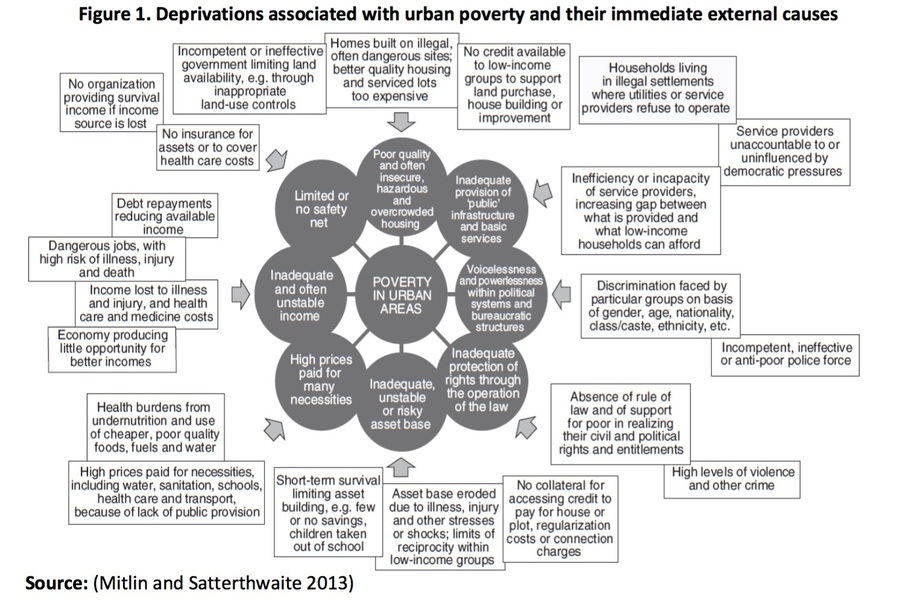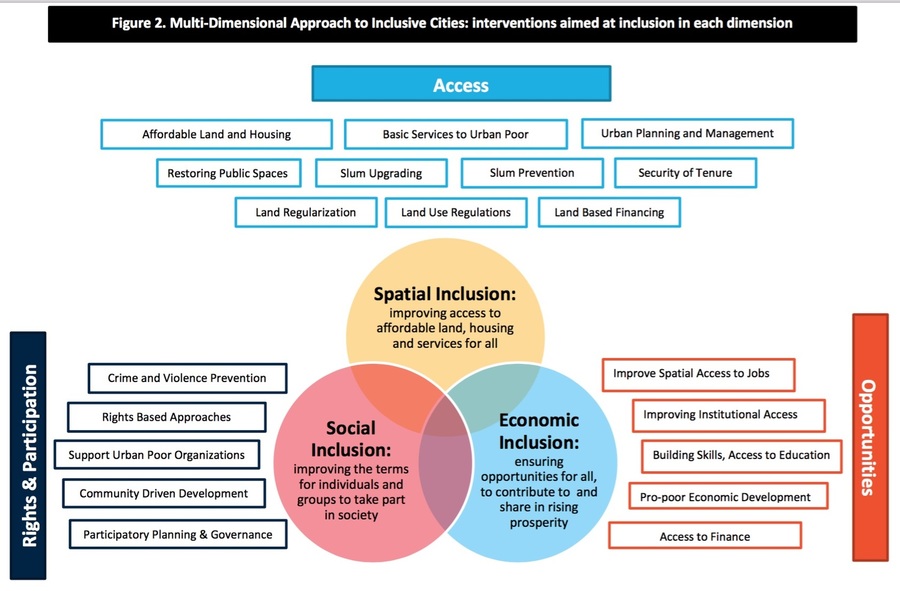Difference between revisions of "World Bank study on Inclusive Cities"
m |
m |
||
| Line 1: | Line 1: | ||
| + | {{Article | ||
| + | |Summary=The main challenge for the social art and design community is to create awareness that apart from integral social, economic and spatial interventions also artistic interventions should be included in order to be effective in realizing an Inclusive City. | ||
| + | |Article==People centred urban development= | ||
| + | |||
| + | Our use of the notion 'Inclusive City' is inspired by a recent World Bank Study. Although the study is mainly based on research in metropoles in Latin America and Asia it provides a very useful framework for analyzing the situation in a city such as Rotterdam. Although this model requires some 'translation' to the West-European context it is more suitable than most Urban Development concepts. These are in most cases focused on how to develop the city in stead of the people actually living in it. The World Bank framework is people centred. | ||
| + | |||
| + | Download the full report here: | ||
| + | [http://documents.worldbank.org/curated/en/402451468169453117/pdf/AUS8539-REVISED-WP-P148654-PUBLIC-Box393236B-Inclusive-Cities-Approach-Paper-w-Annexes-final.pdf World Bank: Inclusive Cities Approach] | ||
| + | |||
| + | |||
| + | |||
| + | [[File:Poverty inclusive city.jpg|External causes of poverty ]] | ||
| + | |||
| + | [[File:Inclusive City Approach 2.jpg|none|World Bank: The Inclusive City Approach ]] | ||
| + | }} | ||
| + | {{Category selector | ||
| + | |Category=Urbanisation | ||
| + | }} | ||
| + | {{Category selector | ||
| + | |Category=Diversity | ||
| + | }} | ||
| + | {{Articles more}} | ||
=People centred urban development= | =People centred urban development= | ||
Our use of the notion 'Inlusive City' is inspired by a recent World Bank Study. Although the study is mainly based on research in metropoles in Latin America and Asia it provides a very useful framework for analysing the situation in a city such as Rotterdam. Although this model requires some 'translation' to the West-European context it is more suitable than most Urban Development concepts. These are in most cases focused on how to develop the city in stead of the people actually living in it. The World Bank framework is people centred. | Our use of the notion 'Inlusive City' is inspired by a recent World Bank Study. Although the study is mainly based on research in metropoles in Latin America and Asia it provides a very useful framework for analysing the situation in a city such as Rotterdam. Although this model requires some 'translation' to the West-European context it is more suitable than most Urban Development concepts. These are in most cases focused on how to develop the city in stead of the people actually living in it. The World Bank framework is people centred. | ||
Revision as of 16:04, 28 November 2017
The wikipage input value is empty (e.g. SomeProperty::, [[]]) and therefore it cannot be used as a name or as part of a query condition.
People centred urban development
Our use of the notion 'Inclusive City' is inspired by a recent World Bank Study. Although the study is mainly based on research in metropoles in Latin America and Asia it provides a very useful framework for analyzing the situation in a city such as Rotterdam. Although this model requires some 'translation' to the West-European context it is more suitable than most Urban Development concepts. These are in most cases focused on how to develop the city in stead of the people actually living in it. The World Bank framework is people centred.
Download the full report here: World Bank: Inclusive Cities Approach
Links
CONTRIBUTE
Feel free to contribute to Beyond Social.
People centred urban development
Our use of the notion 'Inlusive City' is inspired by a recent World Bank Study. Although the study is mainly based on research in metropoles in Latin America and Asia it provides a very useful framework for analysing the situation in a city such as Rotterdam. Although this model requires some 'translation' to the West-European context it is more suitable than most Urban Development concepts. These are in most cases focused on how to develop the city in stead of the people actually living in it. The World Bank framework is people centred.
The main challenge for the social art and design community is to create awareness that apart from integral social, economic and spatial interventions also artistic interventions should be included in order to be effective in realising an Inclusive City.
Download the full report here: World Bank: Inclusive Cities Approach










